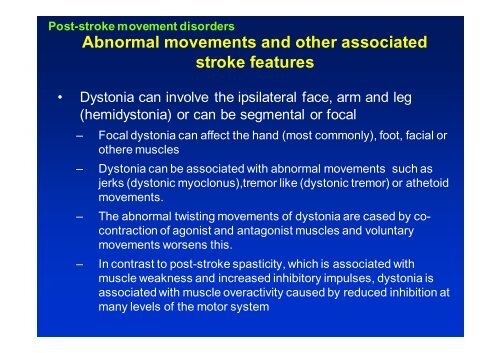Post-stroke movement syndromes
Post-stroke movement syndromes
Post-stroke movement syndromes
You also want an ePaper? Increase the reach of your titles
YUMPU automatically turns print PDFs into web optimized ePapers that Google loves.
<strong>Post</strong>-<strong>stroke</strong> <strong>movement</strong> disorders<br />
Abnormal <strong>movement</strong>s and other associated<br />
<strong>stroke</strong> features<br />
• Dystonia can involve the ipsilateral face, arm and leg<br />
(hemidystonia) or can be segmental or focal<br />
– Focal dystonia can affect the hand (most commonly), foot, facial or<br />
othere muscles<br />
– Dystonia can be associated with abnormal <strong>movement</strong>s such as<br />
jerks (dystonic myoclonus),tremor like (dystonic tremor) or athetoid<br />
<strong>movement</strong>s.<br />
– The abnormal twisting <strong>movement</strong>s of dystonia are cased by cocontraction<br />
of agonist and antagonist muscles and voluntary<br />
<strong>movement</strong>s worsens this.<br />
– In contrast to post-<strong>stroke</strong> spasticity, which is associated with<br />
muscle weakness and increased inhibitory impulses, dystonia is<br />
associated with muscle overactivity caused by reduced inhibition at<br />
many levels of the motor system


